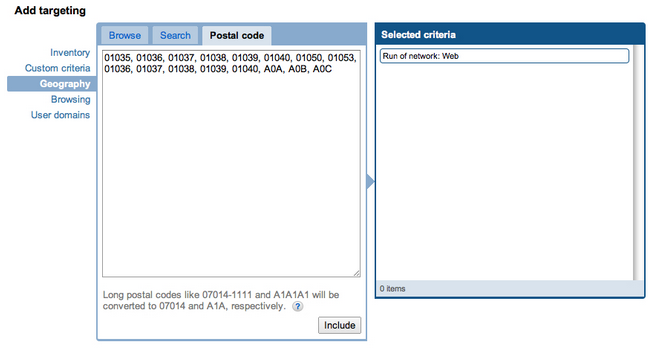Postal code targeting now available in DFP
Posted:
Wednesday, August 31, 2011
Advertisers spend more money on campaigns that reach the right audience. Plus, users find targeted ads more relevant and useful. To help you ensure that ads reach a specific audience and increase the value of your inventory, DoubleClick for Publishers (DFP) offers multiple targeting options that enable you to more precisely control when, where, and to whom, ads appear.
DoubleClick’s technology can recognize a number of factors that can be used in deciding which ads to serve: the visitor's location (country, region or state, metro, and city), day and time, user's domain, user's operating system, browser, browser language, and bandwidth.
Today, we’re excited to release a new addition to this list with zip and postal code targeting. Postal code targeting allows you to take your geo-targeted campaigns a level deeper to precisely reach users in specific markets. For example, you can now target users on Manhattan’s Upper West Side neighborhood (10023, 10024, 10025) instead of geo-targeting the entire New York metropolitan area.
 DFP currently supports targeting to U.S. zip codes and Canadian postal code prefixes. To get started, simply click the 'Postal code' tab in the targeting picker and paste in a comma-separated list of postal codes or prefixes. As with other geo-targeting, you’ll be able to measure the effectiveness of your campaigns by using 'postal code' as a dimension when generating reports.
DFP currently supports targeting to U.S. zip codes and Canadian postal code prefixes. To get started, simply click the 'Postal code' tab in the targeting picker and paste in a comma-separated list of postal codes or prefixes. As with other geo-targeting, you’ll be able to measure the effectiveness of your campaigns by using 'postal code' as a dimension when generating reports.
We look forward to adding the ability to target postal codes in additional countries in the future, and hope that with the expansion of postal code targeting, you’ll be able to reach your audience more effectively.
DoubleClick’s technology can recognize a number of factors that can be used in deciding which ads to serve: the visitor's location (country, region or state, metro, and city), day and time, user's domain, user's operating system, browser, browser language, and bandwidth.
Today, we’re excited to release a new addition to this list with zip and postal code targeting. Postal code targeting allows you to take your geo-targeted campaigns a level deeper to precisely reach users in specific markets. For example, you can now target users on Manhattan’s Upper West Side neighborhood (10023, 10024, 10025) instead of geo-targeting the entire New York metropolitan area.
 DFP currently supports targeting to U.S. zip codes and Canadian postal code prefixes. To get started, simply click the 'Postal code' tab in the targeting picker and paste in a comma-separated list of postal codes or prefixes. As with other geo-targeting, you’ll be able to measure the effectiveness of your campaigns by using 'postal code' as a dimension when generating reports.
DFP currently supports targeting to U.S. zip codes and Canadian postal code prefixes. To get started, simply click the 'Postal code' tab in the targeting picker and paste in a comma-separated list of postal codes or prefixes. As with other geo-targeting, you’ll be able to measure the effectiveness of your campaigns by using 'postal code' as a dimension when generating reports.
We look forward to adding the ability to target postal codes in additional countries in the future, and hope that with the expansion of postal code targeting, you’ll be able to reach your audience more effectively.





